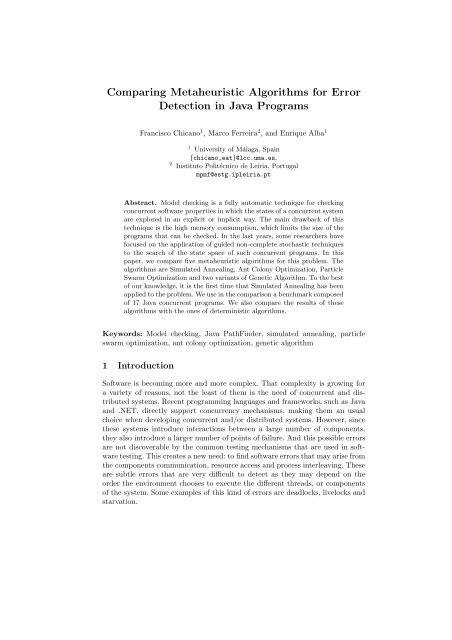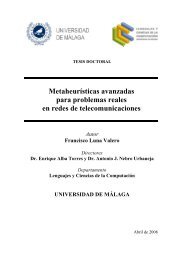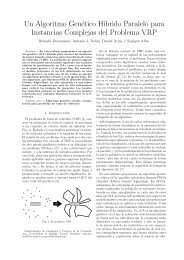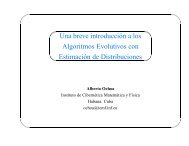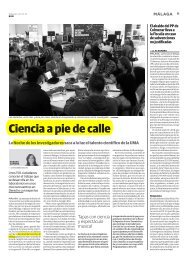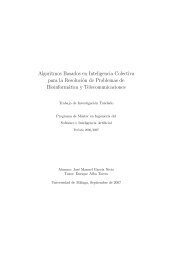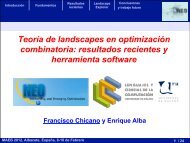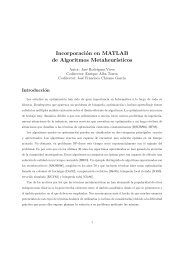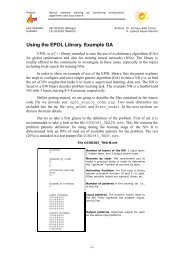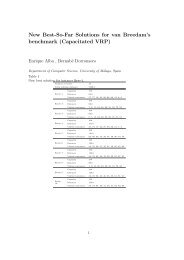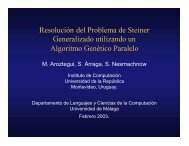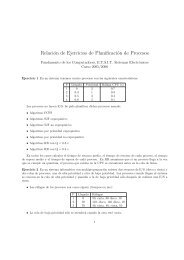Comparing Metaheuristic Algorithms for Error Detection in ... - NEO
Comparing Metaheuristic Algorithms for Error Detection in ... - NEO
Comparing Metaheuristic Algorithms for Error Detection in ... - NEO
You also want an ePaper? Increase the reach of your titles
YUMPU automatically turns print PDFs into web optimized ePapers that Google loves.
<strong>Compar<strong>in</strong>g</strong> <strong>Metaheuristic</strong> <strong>Algorithms</strong> <strong>for</strong> <strong>Error</strong><br />
<strong>Detection</strong> <strong>in</strong> Java Programs<br />
Francisco Chicano 1 , Marco Ferreira 2 , and Enrique Alba 1<br />
1 University of Málaga, Spa<strong>in</strong><br />
{chicano,eat}@lcc.uma.es,<br />
2 Instituto Politécnico de Leiria, Portugal<br />
mpmf@estg.ipleiria.pt<br />
Abstract. Model check<strong>in</strong>g is a fully automatic technique <strong>for</strong> check<strong>in</strong>g<br />
concurrent software properties <strong>in</strong> which the states of a concurrent system<br />
are explored <strong>in</strong> an explicit or implicit way. The ma<strong>in</strong> drawback of this<br />
technique is the high memory consumption, which limits the size of the<br />
programs that can be checked. In the last years, some researchers have<br />
focused on the application of guided non-complete stochastic techniques<br />
to the search of the state space of such concurrent programs. In this<br />
paper, we compare five metaheuristic algorithms <strong>for</strong> this problem. The<br />
algorithms are Simulated Anneal<strong>in</strong>g, Ant Colony Optimization, Particle<br />
Swarm Optimization and two variants of Genetic Algorithm. To the best<br />
of our knowledge, it is the first time that Simulated Anneal<strong>in</strong>g has been<br />
applied to the problem. We use <strong>in</strong> the comparison a benchmark composed<br />
of 17 Java concurrent programs. We also compare the results of these<br />
algorithms with the ones of determ<strong>in</strong>istic algorithms.<br />
Keywords: Model check<strong>in</strong>g, Java PathF<strong>in</strong>der, simulated anneal<strong>in</strong>g, particle<br />
swarm optimization, ant colony optimization, genetic algorithm<br />
1 Introduction<br />
Software is becom<strong>in</strong>g more and more complex. That complexity is grow<strong>in</strong>g <strong>for</strong><br />
a variety of reasons, not the least of them is the need of concurrent and distributed<br />
systems. Recent programm<strong>in</strong>g languages and frameworks, such as Java<br />
and .NET, directly support concurrency mechanisms, mak<strong>in</strong>g them an usual<br />
choice when develop<strong>in</strong>g concurrent and/or distributed systems. However, s<strong>in</strong>ce<br />
these systems <strong>in</strong>troduce <strong>in</strong>teractions between a large number of components,<br />
they also <strong>in</strong>troduce a larger number of po<strong>in</strong>ts of failure. And this possible errors<br />
are not discoverable by the common test<strong>in</strong>g mechanisms that are used <strong>in</strong> software<br />
test<strong>in</strong>g. This creates a new need: to f<strong>in</strong>d software errors that may arise from<br />
the components communication, resource access and process <strong>in</strong>terleav<strong>in</strong>g. These<br />
are subtle errors that are very difficult to detect as they may depend on the<br />
order the environment chooses to execute the different threads, or components<br />
of the system. Some examples of this k<strong>in</strong>d of errors are deadlocks, livelocks and<br />
starvation.
One technique used to validate and verify programs aga<strong>in</strong>st several properties<br />
like the ones mentioned is model check<strong>in</strong>g [1]. Basically, a model checker uses a<br />
simplified implementation of the program, that is, a model, creat<strong>in</strong>g and travers<strong>in</strong>g<br />
the graph of all the possible states of that model to f<strong>in</strong>d a path start<strong>in</strong>g <strong>in</strong><br />
the <strong>in</strong>itial state that violates the given properties. If such a path is found it is a<br />
counterexample of the property that can be used to correct the program. Otherwise,<br />
if the algorithm used <strong>for</strong> the search of the counterexample is complete,<br />
the model is proven to be correct regard<strong>in</strong>g the given properties.<br />
The amount of states of a given concurrent system is very high even <strong>in</strong> the<br />
case of small systems, and it usually <strong>in</strong>creases <strong>in</strong> a exponential way with the size<br />
of the model. This fact is known as the state explosion problem and limits the<br />
size of the model that a model checker can verify. Several techniques exist to alleviate<br />
this problem, such as partial order reduction [2], symmetry reduction [3],<br />
bitstate hash<strong>in</strong>g [4] and symbolic model check<strong>in</strong>g [5]. However, exhaustive search<br />
techniques are always handicapped <strong>in</strong> real concurrent programs because most of<br />
these programs are too complex even <strong>for</strong> the most advanced techniques.<br />
When, even after state or memory reduction is somehow per<strong>for</strong>med, the number<br />
of states becomes too big, two problems appear: the memory required to<br />
search <strong>for</strong> all states is too large and/or the time required to process those states is<br />
extremely long <strong>for</strong> practical purposes. That means that either the model checker<br />
will not be able to f<strong>in</strong>d an error nor prove the correctness of the model or, if it<br />
does f<strong>in</strong>d an error or prove the correctness of the model, it will not be <strong>in</strong> a practical<br />
run time. In those cases, the classical search algorithms like Depth First<br />
Search (DFS) or Breadth First Search (BFS), which are the most commonly<br />
used <strong>in</strong> model check<strong>in</strong>g, are not suited.<br />
However, us<strong>in</strong>g the old software eng<strong>in</strong>eer<strong>in</strong>g adage: “a test is only successful<br />
if it f<strong>in</strong>ds an error”, we can th<strong>in</strong>k of model check<strong>in</strong>g not as a way to prove<br />
correctness, but rather as a technique to locate errors and help <strong>in</strong> the test<strong>in</strong>g<br />
phase of the software life cycle [6]. In this situation, we can stop th<strong>in</strong>k<strong>in</strong>g <strong>in</strong><br />
complete search algorithms and start to th<strong>in</strong>k <strong>in</strong> not complete, but possibly<br />
guided search algorithms that lead to an error (if it exists) faster. That way,<br />
at least one of the objectives of model check<strong>in</strong>g is accomplished. There<strong>for</strong>e,<br />
techniques of bounded (low) complexity as those based on heuristics will be<br />
needed <strong>for</strong> medium/large size programs work<strong>in</strong>g <strong>in</strong> real world scenarios.<br />
In this article we will study the behavior of several algorithms, <strong>in</strong>clud<strong>in</strong>g<br />
determ<strong>in</strong>istic complete, determ<strong>in</strong>istic non-complete, and stochastic non-complete<br />
search algorithms. In particular, the contributions of this work are:<br />
– We analyze, compare and discuss the results of apply<strong>in</strong>g ten algorithms <strong>for</strong><br />
search<strong>in</strong>g errors <strong>in</strong> 17 Java programs.<br />
– We <strong>in</strong>clude <strong>in</strong> the comparison algorithms from four different families of metaheuristics:<br />
evolutionary algorithms (two variants), particle swarm optimization,<br />
simulated anneal<strong>in</strong>g, and ant colony optimization.<br />
– We use a simulated anneal<strong>in</strong>g algorithm (SA) <strong>for</strong> the first time <strong>in</strong> the doma<strong>in</strong><br />
of model check<strong>in</strong>g.
– We use large Java models that actually pose a challenge <strong>for</strong> traditional model<br />
check<strong>in</strong>g techniques and thus expand the spectrum of checkable programs.<br />
The paper is organized as follows. In the next section we <strong>in</strong>troduce some<br />
background <strong>in</strong><strong>for</strong>mation on heuristic model check<strong>in</strong>g and Java PathF<strong>in</strong>der, which<br />
is the model checker used <strong>in</strong> this work. Section 3 presents a <strong>for</strong>mal def<strong>in</strong>ition of<br />
the problem at hands. In Section 4 we briefly present the algorithms used <strong>in</strong> the<br />
experimental study and their parameters. Then, we describe the experiments<br />
per<strong>for</strong>med and discuss the obta<strong>in</strong>ed results <strong>in</strong> Section 5. We conclude the paper<br />
<strong>in</strong> Section 6.<br />
2 Heuristic Model Check<strong>in</strong>g<br />
The search <strong>for</strong> errors <strong>in</strong> a model can be trans<strong>for</strong>med <strong>in</strong> the search <strong>for</strong> one objective<br />
node (a program state that violates a given condition) <strong>in</strong> a graph, the<br />
transition graph of the program, which conta<strong>in</strong>s all the possible states of the<br />
program. For example, if we want to check the absence of deadlocks <strong>in</strong> a Java<br />
program we have to search <strong>for</strong> states with no successors that are not end states.<br />
Once we have trans<strong>for</strong>med the search <strong>for</strong> errors <strong>in</strong> a search <strong>in</strong> a graph, we can<br />
use classical algorithms <strong>for</strong> graph exploration to f<strong>in</strong>d the errors. Some classical<br />
algorithms used <strong>in</strong> the literature with this aim are depth first search (DFS)<br />
or breadth first search (BFS). It is also possible to apply graph exploration<br />
algorithms that takes <strong>in</strong>to account heuristic <strong>in</strong><strong>for</strong>mation, like A ∗ , Weighted A ∗ ,<br />
Iterative Deep<strong>in</strong>g A ∗ , and Best First Search. When heuristic <strong>in</strong><strong>for</strong>mation is used<br />
<strong>in</strong> the search, we need a map from the states to the heuristic values. In the<br />
general case, this maps depends on the property to check and the heuristic value<br />
represents a preference to explore the correspond<strong>in</strong>g state. The map is usually<br />
called heuristic function, that we denote here with h. The lower the value of h<br />
the higher the preference to explore the state, s<strong>in</strong>ce it can be near an objective<br />
node.<br />
The utilization of heuristic <strong>in</strong><strong>for</strong>mation to guide the search <strong>for</strong> errors <strong>in</strong> model<br />
check<strong>in</strong>g is called heuristic (or guided) model check<strong>in</strong>g. The heuristic functions<br />
are designed to guide the search first to the regions of the transition graph <strong>in</strong><br />
which the probability of f<strong>in</strong>d<strong>in</strong>g an error state is higher. This way, the time<br />
and memory required to search an error <strong>in</strong> a program is decreased on average.<br />
However, the utilization of heuristic <strong>in</strong><strong>for</strong>mation has no advantage when the<br />
program has no error. In this case, the whole transition graph must be explored.<br />
A well-known class of non-exhaustive algorithms <strong>for</strong> solv<strong>in</strong>g complex problems<br />
is the class of metaheuristic algorithms [7]. They are search algorithms used<br />
<strong>in</strong> optimization problems that can f<strong>in</strong>d good quality solutions <strong>in</strong> a reasonable<br />
time. <strong>Metaheuristic</strong> algorithms have been previously applied to the search of<br />
errors <strong>in</strong> concurrent programs. In [8], Godefroid and Khurshid applied Genetic<br />
<strong>Algorithms</strong> <strong>in</strong> one of the first work on this topic. More recently, Alba and Chicano<br />
used Ant Colony Optimization [9] and Staunton and Clark applied Estimation<br />
of Distribution <strong>Algorithms</strong> [10].
2.1 Verification <strong>in</strong> Java PathF<strong>in</strong>der<br />
There are different ways of specify<strong>in</strong>g the model and the desired properties.<br />
Each model checker has its own way of do<strong>in</strong>g it. For example, <strong>in</strong> SPIN [4] the<br />
model is specified <strong>in</strong> the Promela language and the properties are specified us<strong>in</strong>g<br />
L<strong>in</strong>ear Temporal Logic (LTL). It is usual to provide the model checker with the<br />
properties specified us<strong>in</strong>g temporal logic <strong>for</strong>mulas, either <strong>in</strong> LTL or CTL. It<br />
is also usual to f<strong>in</strong>d specific modell<strong>in</strong>g languages <strong>for</strong> different model checkers.<br />
Promela, DVE, and SMV are just some examples. However, model checkers<br />
exist that deal with models written <strong>in</strong> popular programm<strong>in</strong>g languages, like C<br />
or Java. This is the case of Java PathF<strong>in</strong>der (JPF) [11], which is able to verify<br />
models implemented <strong>in</strong> JVM 3 bytecodes (the source code of the models is not<br />
required). The properties are also specified <strong>in</strong> a different way <strong>in</strong> JPF. Instead<br />
of us<strong>in</strong>g temporal logic <strong>for</strong>mulas, the JPF user has to implement a class that<br />
tells the verifier algorithm if the property holds or not after query<strong>in</strong>g the JVM<br />
<strong>in</strong>ternal state. Out of the box, JPF is able to check the absence of deadlocks and<br />
unhandled exceptions (this <strong>in</strong>cludes assertion violations). Both k<strong>in</strong>d of properties<br />
belong to the class of safety properties [12].<br />
In order to search <strong>for</strong> errors, JPF takes the .class files (conta<strong>in</strong><strong>in</strong>g the JVM<br />
bytecodes) and use its own Java virtual mach<strong>in</strong>e implementation (JPF-JVM <strong>in</strong><br />
the follow<strong>in</strong>g) to advance the program <strong>in</strong>struction by <strong>in</strong>struction. When two or<br />
more <strong>in</strong>structions can be executed, one of them is selected by the search algorithm<br />
and the other ones are saved <strong>for</strong> future exploration. The search algorithm<br />
can query the JVM <strong>in</strong>ternal state at any moment of the search as well as store<br />
a given state of the JVM and restore a previously stored state. From the po<strong>in</strong>t<br />
of view of the Java model be<strong>in</strong>g verified, the JPF-JVM is not different from<br />
any other JVM: the execution of the <strong>in</strong>structions have the same behaviour. The<br />
JPF-JVM is controlled by the search algorithm, which is an <strong>in</strong>stance of a subclass<br />
of the Search class. In order to <strong>in</strong>clude a new search algorithm <strong>in</strong> JPF, the<br />
developer has to create a new class and implement the correspond<strong>in</strong>g methods.<br />
This way, JPF can be easily extended; one aspect that is miss<strong>in</strong>g <strong>in</strong> other model<br />
checkers like SPIN. The role of the search algorithm is to control the order <strong>in</strong><br />
which the states are explored accord<strong>in</strong>g to the search strategy and to detect the<br />
presence of property violations <strong>in</strong> the explored states.<br />
In JPF, it is possible to use search algorithms guided by heuristic <strong>in</strong><strong>for</strong>mation.<br />
To this aim, JPF provides some classes that ease the implementation of heuristic<br />
functions and heuristically-guided search algorithms.<br />
3 Problem Formalization<br />
In this paper we tackle the problem of search<strong>in</strong>g <strong>for</strong> safety property violations <strong>in</strong><br />
concurrent systems. As we previously mentioned, this problem can be translated<br />
<strong>in</strong>to the search of a walk <strong>in</strong> a graph (the transition graph of the program) start<strong>in</strong>g<br />
3 JVM stands <strong>for</strong> Java Virtual Mach<strong>in</strong>e
<strong>in</strong> the <strong>in</strong>itial state and end<strong>in</strong>g <strong>in</strong> an objective node (error state). We <strong>for</strong>malize<br />
here the problem as follows.<br />
Let G = (S, T) be a directed graph where S is the set of nodes and T ⊆ S ×S<br />
is the set of arcs. Let q ∈ S be the <strong>in</strong>itial node of the graph, F ⊆ S a set<br />
of dist<strong>in</strong>guished nodes that we call objective nodes. We denote with T(s) the<br />
set of successors of node s. A f<strong>in</strong>ite walk over the graph is a sequence of nodes<br />
π = π1π2 . . . πn where πi ∈ S <strong>for</strong> i = 1, 2, . . ., n and πi ∈ T(πi−1) <strong>for</strong> i = 2, . . .,n.<br />
We denote with πi the ith node of the sequence and we use |π| to refer to the<br />
length of the walk, that is, the number of nodes of π. We say that a walk π is a<br />
start<strong>in</strong>g walk if the first node of the walk is the <strong>in</strong>itial node of the graph, that<br />
is, π1 = q.<br />
Given a directed graph G, the problem at hand consists <strong>in</strong> f<strong>in</strong>d<strong>in</strong>g a start<strong>in</strong>g<br />
walk π (π1 = q) that ends <strong>in</strong> an objective node, that is, π∗ ∈ F. The graph G<br />
used <strong>in</strong> the problem is the transition graph of the program. The set of nodes S<br />
<strong>in</strong> G is the set of states <strong>in</strong> of the program, the set of arcs T <strong>in</strong> G is the set of<br />
transitions between states <strong>in</strong> the program, the <strong>in</strong>itial node q <strong>in</strong> G is the <strong>in</strong>itial<br />
state of the program, the set of objective nodes F <strong>in</strong> G is the set of error states<br />
<strong>in</strong> the program. In the follow<strong>in</strong>g, we will also use the words state, transition and<br />
error state to refer to the elements <strong>in</strong> S, T and F, respectively. The transition<br />
graph of the program is usually so large that it cannot be completely stored <strong>in</strong><br />
the memory of a computer. Thus, the graph is build as the search progresses.<br />
When we compute the states that are successors <strong>in</strong> the transition graph of a<br />
given state s we say that we have expanded the state.<br />
4 <strong>Algorithms</strong><br />
In this section we will present the details and configurations of the ten algorithms<br />
we use <strong>in</strong> the experimental section. In Table 1 we show the ten algorithms classified<br />
accord<strong>in</strong>g two three criteria: completeness, determ<strong>in</strong>ism and guidance. We<br />
say that an algorithm is complete if the algorithm ensures the exploration of<br />
the whole transition graph when no error exists. For example, DFS and BFS<br />
are complete algorithms, but Beam Search and all the metaheuristic algorithms<br />
used here are non-complete algorithms. One algorithm is determ<strong>in</strong>istic if the<br />
states are explored <strong>in</strong> the same order each time the algorithms is run. DFS and<br />
Beam Search are examples of determ<strong>in</strong>istic algorithms, while Random Search<br />
and all the metaheuristics are non-determ<strong>in</strong>istic algorithms. Guidance refers to<br />
the use of heuristic <strong>in</strong><strong>for</strong>mation. We say that an algorithm is guided when it uses<br />
heuristic <strong>in</strong><strong>for</strong>mation. A ∗ and Beam Search are guided algorithms while Random<br />
Search and BFS are unguided algorithms.<br />
For the evaluation of the tentative solutions (walks <strong>in</strong> the transition graph) we<br />
use the same objective function (also called fitness function) <strong>in</strong> all the algorithms.<br />
Our objective is to f<strong>in</strong>d deadlocks <strong>in</strong> the programs and we prefer short walks.<br />
As such, our fitness function f is def<strong>in</strong>ed as follows:<br />
f(x) = deadlock + numblocked +<br />
1<br />
1 + pathlen<br />
(1)
Table 1. <strong>Algorithms</strong> used <strong>in</strong> the experimental section<br />
Algorihm Acronym Complete? Determ<strong>in</strong>istic? Guided?<br />
Depth First Search [11] DFS yes yes no<br />
Breadth First Search [11] BFS yes yes no<br />
A ∗ [11] A ∗<br />
yes yes yes<br />
Genetic Algorithm [13] GA no no yes<br />
Genetic Algorithm [13]<br />
with Memory Operator<br />
GAMO no no yes<br />
Particle Swarm Optimization [14] PSO no no yes<br />
Ant Colony Optimization [9] ACOhg no no yes<br />
Simulated Anneal<strong>in</strong>g SA no no yes<br />
Random Search RS no no no<br />
Beam Search [11] BS no yes yes<br />
where numblocked is the number of blocked threads generated by the walk while<br />
pathlen represents the number of transitions <strong>in</strong> the walk and deadlock is a constant<br />
which takes a high value if a deadlock was found and 0 otherwise. The<br />
high value that deadlock can take should be larger than the maximum number<br />
of threads <strong>in</strong> the program. This way we can ensure that any walk lead<strong>in</strong>g to a<br />
deadlock has better fitness than any walk without deadlock. All the metaheuristic<br />
algorithms try to maximize f.<br />
The random search is a really simple algorithm that works by build<strong>in</strong>g<br />
limited-length random paths from the <strong>in</strong>itial node of the graph. Then, it checks<br />
if an error was found <strong>in</strong> the path.<br />
In the follow<strong>in</strong>g we describe the SA algorithm, s<strong>in</strong>ce it is the first time that<br />
this algorithm is applied to this problem (up to the best of our knowledge).<br />
We omit the details of the rema<strong>in</strong><strong>in</strong>g algorithms due to space constra<strong>in</strong>ts. The<br />
<strong>in</strong>terested reader should refer to the correspond<strong>in</strong>g reference (shown <strong>in</strong> Table 1).<br />
4.1 Simulated Anneal<strong>in</strong>g<br />
Simulated anneal<strong>in</strong>g (SA) is a trajectory-based metaheuristic <strong>in</strong>troduced by<br />
Kirkpatrick et al. <strong>in</strong> 1983 [15]. It is based on the statistical mechanics of anneal<strong>in</strong>g<br />
<strong>in</strong> solids. Just like <strong>in</strong> the physical anneal<strong>in</strong>g, SA allows the solution to<br />
vary significantly while the virtual temperature is high and stabilizes the changes<br />
as the temperature lows, freez<strong>in</strong>g it when the temperature reaches 0. We show<br />
the pseudocode of SA <strong>in</strong> Algorithm 1.<br />
SA works by generat<strong>in</strong>g an <strong>in</strong>itial solution S, usually <strong>in</strong> some random <strong>for</strong>m,<br />
and sett<strong>in</strong>g the temperature T to an <strong>in</strong>itial (high) temperature. Then, while<br />
some stopp<strong>in</strong>g criteria is not met, SA randomly selects a neighbor solution N<br />
of S and compares its energy (or fitness) aga<strong>in</strong>st the current solution’s energy,<br />
gett<strong>in</strong>g the difference ∆E <strong>in</strong> temperature between them. The neighbor solution<br />
is accepted as the new solution if it is better than the current one or, <strong>in</strong> case it<br />
is worse, with a probability that is dependent on both ∆E and temperature T.
Algorithm 1 Pseudo code of Simulated Anneal<strong>in</strong>g<br />
1: S = generateInitialSolution();<br />
2: T = <strong>in</strong>itialTemperature;<br />
3: while not stopp<strong>in</strong>gCondition() do<br />
4: N = getRandomNeighbor(S);<br />
5: ∆E = energy(N) - energy(S);<br />
6: if ∆E > 0 OR random(0,1) < probabilityAcceptance(∆E, T) then<br />
7: S = N<br />
8: end if<br />
9: T = updateTemperature(T);<br />
10: end while<br />
11: return S<br />
SA then updates the temperature us<strong>in</strong>g some sort of decay<strong>in</strong>g method. When<br />
the stopp<strong>in</strong>g criteria is met, the algorithm returns the current solution S.<br />
The energy function <strong>in</strong> this case is the objective function f def<strong>in</strong>ed <strong>in</strong> Equation<br />
(1). S<strong>in</strong>ce we want to maximize this function (the energy), given an energy<br />
<strong>in</strong>crease ∆E and a temperature T, the probability of acceptance is computed<br />
us<strong>in</strong>g the follow<strong>in</strong>g expression:<br />
probabilityAcceptance(∆E, T) = e ∆E<br />
T (2)<br />
One critical function of the Simulated Anneal<strong>in</strong>g is the updateTemperature<br />
function. There are several different ways to implement this method. In our<br />
implementation we used a simple, yet commonly used technique: multiply<strong>in</strong>g<br />
the temperature by a number α between 0 and 1 (exclusive). The smaller that<br />
number is, the faster the temperature will drop. However, if we detect a local<br />
maxima (if the solution isn’t improved <strong>for</strong> a number of iterations) we reset the<br />
temperature to its <strong>in</strong>itial value to explore new regions.<br />
4.2 Parameter sett<strong>in</strong>gs<br />
In a comparison of different k<strong>in</strong>ds of algorithms one problem always poses: how<br />
to compare them <strong>in</strong> a fair way? This problem is aggravated by the fact that the<br />
algorithms work <strong>in</strong> fundamentally different ways: some algorithms search only<br />
one state at a time, some search <strong>for</strong> paths. Some check only one state per iteration,<br />
others check many more states per iteration, etc. This large diversification<br />
makes it very hard to select the parameters that make the comparison fair. The<br />
fairest comparison criterion seems to be the computational time available to each<br />
algorithm. However, this criterion would make it impossible to use the results <strong>in</strong><br />
a future comparison because the execution environment can, and probably will,<br />
change. Furthermore, the implementation details also affect the execution time<br />
and we cannot guarantee that the implementations used <strong>in</strong> the experiments are<br />
the most effective ones. For this reason, we decided to established a common<br />
limit <strong>for</strong> the number of states each algorithm may expand. After a def<strong>in</strong>ed num-
er of states have been expanded the search is stopped and the results can be<br />
compared.<br />
In order to ma<strong>in</strong>ta<strong>in</strong> the parameterization simple, we used the same maximum<br />
number of expanded states <strong>for</strong> every model even though the size of each<br />
model is considerably different. We def<strong>in</strong>ed that maximum number of states to be<br />
200 000, as it was empirically verified to be large enough to allow the algorithms<br />
to f<strong>in</strong>d errors even on the largest models. Hav<strong>in</strong>g established a common value<br />
<strong>for</strong> the ef<strong>for</strong>t each algorithm may use, the parameterization of each <strong>in</strong>dividual<br />
algorithm can be substantially different from each other. For <strong>in</strong>stance, we don’t<br />
have to def<strong>in</strong>e the same number of <strong>in</strong>dividuals <strong>in</strong> the GA as the same number of<br />
particles <strong>in</strong> the PSO or as the same number of ants <strong>in</strong> the ACO. This gives us<br />
the freedom to choose the best set of parameters <strong>for</strong> each algorithm. However, <strong>in</strong><br />
the case of the stochastic algorithms, and s<strong>in</strong>ce this is a parameter that largely<br />
affects their execution, we have used the same heuristic function <strong>for</strong> all of them.<br />
DFS, BFS and A* do not require any parameter to be set as they are generic,<br />
complete and determ<strong>in</strong>istic search algorithms. For the metaheuristic algorithms,<br />
on the other hand, there are a variety of parameters to be set and although they<br />
could be optimized <strong>for</strong> each <strong>in</strong>dividual experiment, we have opted to use the same<br />
set of parameters <strong>for</strong> every experiment. These parameters were obta<strong>in</strong>ed after<br />
some prelim<strong>in</strong>ary experiments try<strong>in</strong>g to get the best results <strong>for</strong> each particular<br />
algorithm. The parameters are summarized, together with the ones of RS and<br />
BS, <strong>in</strong> Table 2.<br />
5 Experimental Section<br />
In our experiments we want to verify the applicability of metaheuristic algorithms<br />
to model check<strong>in</strong>g. We per<strong>for</strong>med several experiments us<strong>in</strong>g the algorithms<br />
of the previous section and different Java implemented models. In order<br />
to determ<strong>in</strong>e the behavior of each search algorithm we have selected several types<br />
of models, <strong>in</strong>clud<strong>in</strong>g the classical D<strong>in</strong><strong>in</strong>g Philosophers toy model (both <strong>in</strong> a cyclic<br />
and a non-cyclic version), the more complex Stable Marriage Problem and two<br />
different communication protocols: GIOP and GARP. The D<strong>in</strong><strong>in</strong>g Philosopher<br />
models illustrate the common deadlock that can appear on multi-threaded algorithms.<br />
The difference of the cyclic and non-cyclic version is that while <strong>in</strong> the<br />
first one, called phi, each philosopher cycles through the pick <strong>for</strong>ks, eat, drop<br />
<strong>for</strong>ks and th<strong>in</strong>k states, <strong>in</strong> the non-cyclic version, called d<strong>in</strong>, each philosopher<br />
only picks the <strong>for</strong>ks, eats and drops the <strong>for</strong>ks once, thus limit<strong>in</strong>g the number of<br />
possible deadlocks. The Stable Marriage Problem (mar) has more <strong>in</strong>teractions<br />
between threads and its implementation leads to a dynamic number of threads<br />
dur<strong>in</strong>g executions. It conta<strong>in</strong>s both a deadlock and an assertion violation. Both<br />
the D<strong>in</strong><strong>in</strong>g Philosophers problem and the Stable Marriage Problem can be <strong>in</strong>stantiated<br />
<strong>in</strong> any size (scalable), which makes them good choices to study the<br />
behavior of the search algorithms as the model grows. F<strong>in</strong>ally, the communication<br />
protocols represent another typical class of distributed systems prone<br />
to errors. Both of these protocol implementations have known deadlocks which
Table 2. Parameters of the algorithms<br />
Beam Search Random Search<br />
Parameter Value Parameter Value<br />
Queue limit (k) 10 Path length 350<br />
GeGA algorithm<br />
Parameter Value<br />
M<strong>in</strong>imum path size 10<br />
Maximum path size 350<br />
Population size 50<br />
Selection operator Tournament (5 <strong>in</strong>dividuals)<br />
Crossover probability 0.7<br />
Mutation probability 0.01<br />
Elitism true (5 <strong>in</strong>dividuals)<br />
Respawn after 5 generations with same population average fitness<br />
or 50 generations without improvement <strong>in</strong> best fitness<br />
GeGAMO algorithm<br />
Parameter Value<br />
M<strong>in</strong>imum path size 10<br />
Maximum path size 50<br />
Population size 50<br />
Selection operator Tournament (3 <strong>in</strong>dividuals)<br />
Crossover probability 0.7<br />
Mutation probability 0.01<br />
Elitism true (3 <strong>in</strong>dividuals)<br />
Memory operator frequency 10<br />
Memory operator size 25<br />
Respawn after 5 generations with same population average fitness<br />
or 60 generations without improvement <strong>in</strong> best fitness<br />
PSO algorithm ACOhg algorithm<br />
Parameter Value Parameter Value<br />
Number of Particles 10 Length of ant paths 300<br />
M<strong>in</strong>imum path size 10 Colony size 5<br />
Maximum path size 350 Pheromone power (α) 1<br />
Iterations Until Perturbation 5 Heuristic power (β) 2<br />
Initial <strong>in</strong>ertia 1.2 Evaporation rate (ρ) 0.2<br />
F<strong>in</strong>al <strong>in</strong>ertia 0.6 Stored solutions (ι) 10<br />
Inertia change factor 0.99 Stage length (σs) 3<br />
SA algorithm<br />
Parameter Value<br />
Path size 350<br />
Initial temperature 10<br />
Temperature decay rate (α) 0.9<br />
Iterations without improvement 50<br />
makes them suitable <strong>for</strong> non-complete search algorithms, because although they<br />
cannot prove correctness of a model, they can be used to prove the <strong>in</strong>correctness<br />
and help the programmer to understand and fix the properties violations.<br />
The results obta<strong>in</strong>ed from the experiments can be analyzed <strong>in</strong> several ways.<br />
We will discuss the results on the success of each algorithm <strong>in</strong> f<strong>in</strong>d<strong>in</strong>g the errors,<br />
measured as the hit rate, and the length of the error trail lead<strong>in</strong>g to the error.<br />
Determ<strong>in</strong>istic algorithms always explore the states <strong>in</strong> the same order, which<br />
means that only one execution per problem <strong>in</strong>stance is needed. The results of<br />
stochastic search algorithms, however, could change at each execution. For this<br />
reason, each stochastic algorithm was executed 100 times per problem <strong>in</strong>stance.
5.1 Hit rate<br />
We show the results of hit rate <strong>in</strong> Table 3. Regard<strong>in</strong>g the D<strong>in</strong><strong>in</strong>g Philosophers<br />
cyclic problem (phi), we can observe that none of the exact search algorithms<br />
could f<strong>in</strong>d an error <strong>in</strong> the larger <strong>in</strong>stances. In fact, all of them (DFS, BFS and A*)<br />
exhausted the available memory start<strong>in</strong>g with 12 philosophers, while all of the<br />
stochastic search algorithms (GA, GAMO, PSO, SA, ACOhg and even RS) and<br />
BS had a high hit rate <strong>in</strong> all of the <strong>in</strong>stances. To better understand the reason <strong>for</strong><br />
this, Figure 1(a) shows the distribution of the explored states after 200 000 states<br />
had been observed by two exact algorithms (DFS and BFS) and two stochastic<br />
algorithms (GA and RS). The rema<strong>in</strong><strong>in</strong>g search algorithms were removed from<br />
the figure <strong>in</strong> order to have an uncluttered graphic. Figure 1(a) shows that DFS<br />
searched only one state per depth level (states explored <strong>in</strong> depths superior to 350<br />
are not shown to ma<strong>in</strong>ta<strong>in</strong> the graphic readability). That is coherent with the<br />
search algorithm which searches first <strong>in</strong> depth. However, this makes it difficult to<br />
f<strong>in</strong>d the error if it is not on the first transitions of each state. BFS, on the other<br />
hand, tried to fully explore each depth level be<strong>for</strong>e advanc<strong>in</strong>g to the next one.<br />
However, s<strong>in</strong>ce the phi problem is a very wide problem (mean<strong>in</strong>g that at each<br />
state there is a large number of possible outgo<strong>in</strong>g transitions), the 200 000 states<br />
limit was reached quite fast. We can see a large difference <strong>in</strong> the behavior of the<br />
stochastic search algorithms. Both explore the search space both widely and <strong>in</strong><br />
depth, simultaneously. This means that they avoid us<strong>in</strong>g all the resources <strong>in</strong> the<br />
few first depth levels, but also do not try to search too deep. Although they only<br />
visit the same number of states as their exact counterparts, they are spreader<br />
than the exact algorithms, which helps them f<strong>in</strong>d the error state. Consider<strong>in</strong>g<br />
that there are paths lead<strong>in</strong>g to errors <strong>in</strong> depths around 60, it is easy to see <strong>in</strong><br />
Figure 1(a) why the stochastic algorithms found at least one of them while the<br />
exact algorithms missed them.<br />
Number of dierent states<br />
2000<br />
1600<br />
1200<br />
800<br />
400<br />
0<br />
0<br />
DFS BFS GA RS<br />
50 100 150 200<br />
Depth<br />
250 300 350<br />
(a) DFS, BDS, GA and RS <strong>in</strong> phi.<br />
Number of dierent states<br />
35000<br />
30000<br />
25000<br />
20000<br />
15000<br />
10000<br />
5000<br />
DFS BFS<br />
0 0 10 20 30 40 50<br />
Depth<br />
(b) DFS and BFS <strong>in</strong> d<strong>in</strong>.<br />
Fig.1. Search behavior of algorithms. The X axis is the depth <strong>in</strong> the graph and the<br />
Y axis is the number of expanded states.
Table 3. Hit rate of the algorithms.<br />
Problem DFS BFS A* GA GAMO PSO SA ACOhg RS BS<br />
phi 4 100 100 100 100 100 100 100 100 100 100<br />
phi 12 0 0 0 100 100 100 100 100 100 100<br />
phi 20 0 0 0 100 100 100 100 100 100 100<br />
phi 28 0 0 0 100 100 100 100 100 100 100<br />
phi 36 0 0 0 82 100 53 79 100 100 100<br />
d<strong>in</strong> 4 100 100 100 100 100 100 100 100 100 100<br />
d<strong>in</strong> 8 100 0 0 100 100 100 76 100 96 100<br />
d<strong>in</strong> 12 100 0 0 100 96 85 13 68 0 100<br />
d<strong>in</strong> 16 0 0 0 91 58 20 0 2 0 100<br />
d<strong>in</strong> 20 0 0 0 52 24 0 0 0 0 100<br />
mar 2 100 100 100 100 100 100 100 100 100 100<br />
mar 4 100 100 100 100 100 100 96 100 100 100<br />
mar 6 100 0 0 100 100 100 100 100 100 100<br />
mar 8 100 0 0 100 95 100 100 100 100 100<br />
mar 10 100 0 0 100 25 100 100 100 100 100<br />
giop 100 0 0 100 68 100 100 100 100 100<br />
garp 0 0 0 100 2 80 87 87 100 0<br />
On the non-cyclic version of D<strong>in</strong><strong>in</strong>g Philosophers (d<strong>in</strong>), DFS was able to<br />
detect errors <strong>in</strong> larger <strong>in</strong>stances than the other exact algorithms. Figure 1(b)<br />
shows the reason why: s<strong>in</strong>ce this problem is not cyclic, it ends after all the<br />
philosophers have had their d<strong>in</strong>ner. Consider<strong>in</strong>g 12 philosophers, this happens,<br />
<strong>in</strong>variably, after 50 transitions. S<strong>in</strong>ce DFS has no more states to follow it starts to<br />
backtrack and check other transitions at the previous states. DFS concentrates<br />
its search at the end of the search space, and s<strong>in</strong>ce the error state is at depth 36<br />
(which is near the end), it is able to backtrack and explore other states at that<br />
depth level be<strong>for</strong>e consum<strong>in</strong>g all the available memory. Figure 1(b) shows how<br />
many different states per depth level the DFS and BFS algorithms had checked<br />
after 200 000 expanded states. Although 200 000 were not enough <strong>for</strong> BFS to<br />
f<strong>in</strong>d the error, we can see that DFS was already explor<strong>in</strong>g <strong>in</strong> the error state<br />
neighborhood. BFS, on the other hand, concentrates the search <strong>in</strong> the beg<strong>in</strong>n<strong>in</strong>g<br />
of the search space and, after visit<strong>in</strong>g 200 000 states, it is still far from the<br />
neighborhood of the error state. The d<strong>in</strong> problem is much less <strong>for</strong>giv<strong>in</strong>g than<br />
phi. There is only one error state, and one chance to f<strong>in</strong>d it. This creates an<br />
<strong>in</strong>terest<strong>in</strong>g problem: the probability that a random walk through the search space<br />
would f<strong>in</strong>d the error decreases substantially. In fact, our results show exactly that:<br />
RS starts to miss the error as the number of philosophers grow (and search space<br />
<strong>in</strong>creases, there<strong>for</strong>e). All the metaheuristic search algorithms found the error <strong>in</strong><br />
larger <strong>in</strong>stances, but they too started to struggle to f<strong>in</strong>d it. Only the genetic<br />
algorithms found the error <strong>in</strong> all <strong>in</strong>stances. S<strong>in</strong>ce these are the only algorithms<br />
<strong>in</strong> the set that mixes paths from different <strong>in</strong>dividuals to create new ones, it
seems that they were able to f<strong>in</strong>d a pattern to reach the error, while the other<br />
stochastic algorithms have not. F<strong>in</strong>ally, BS f<strong>in</strong>ds the error <strong>in</strong> all the cases.<br />
Like the d<strong>in</strong> problem, mar is also f<strong>in</strong>ite. This means that there is a (relatively<br />
small) limit on the maximum depth the search algorithm may look <strong>in</strong>to. This<br />
knowledge, and the fact that DFS successfully found an error <strong>in</strong> all the problem<br />
<strong>in</strong>stances may lead us to th<strong>in</strong>k that the problem is small and, there<strong>for</strong>e, simple.<br />
That is not, however, the case: the size of the search space grows exponentially<br />
with the size of couples. An <strong>in</strong>terest<strong>in</strong>g observation is that shape of the search<br />
space rema<strong>in</strong>s ma<strong>in</strong>ly unaffected with the growth of the number of couples, as<br />
seen <strong>in</strong> Figure 2. Consider<strong>in</strong>g the size of the search space, the good results of RS<br />
and the observations we made on the D<strong>in</strong><strong>in</strong>g Philosophers problems, it seems<br />
that the mar problem have many different paths lead<strong>in</strong>g to an error state. To<br />
check this hypothesis we have checked all of the search space <strong>for</strong> the mar problem<br />
with 3 couples and found that with only 5156 different states <strong>in</strong> the search space,<br />
there are 30 error states and 216 different paths lead<strong>in</strong>g to those error states.<br />
This is <strong>in</strong>deed a large number of paths <strong>for</strong> the search space size and supports<br />
our hypothesis.<br />
Number of dierent states<br />
100000<br />
10000<br />
1000<br />
100<br />
10<br />
mar2<br />
mar3<br />
mar4<br />
1 0 15 30 45 60 75<br />
Fig.2. Search space <strong>for</strong> the mar problem as seen by DFS <strong>for</strong> <strong>in</strong>stances of 2, 3 and 4<br />
couples. Note that the Y axis is logarithmic.<br />
In general, when search<strong>in</strong>g <strong>for</strong> errors, we have observed that non-complete<br />
algorithms have a higher success rate than the tested complete algorithms. From<br />
figures 1(b) and 2 we can observe that one reason seems to be the concentration<br />
of the search <strong>in</strong> either the beg<strong>in</strong>n<strong>in</strong>g of it (BFS) or the end of it (DFS). Pure<br />
stochastic algorithms, like random search, explores a wider portion of the space<br />
at all the allowed depths (our random implementation is depth bounded). The<br />
metaheuristic algorithms tend to explore more through the search space and exploit<br />
areas that seem <strong>in</strong>terest<strong>in</strong>g, which typically are neither at the beg<strong>in</strong>n<strong>in</strong>g or<br />
at the end of the search space. Complete search algorithms start to fail to search<br />
the whole search space very soon. Are they really applicable <strong>for</strong> software model<br />
Depth
check<strong>in</strong>g? If some <strong>for</strong>m of abstraction can be used, then maybe. However they<br />
still require large amount of memory and they are not check<strong>in</strong>g the f<strong>in</strong>al implementation,<br />
so specific implementation details could still violate the properties<br />
checked be<strong>for</strong>e. However, fail<strong>in</strong>g to prove the model correctness does not mean<br />
they cannot be used to f<strong>in</strong>d errors. The mar problem is a good example of that.<br />
The search space could not be completely verified after us<strong>in</strong>g only 4 couples,<br />
but DFS was able to f<strong>in</strong>d errors even with 10 couples. The ability of DFS and<br />
BFS to f<strong>in</strong>d errors <strong>in</strong> large search spaces depends not so much on the size of the<br />
search space but more on its shape, as shown <strong>in</strong> the d<strong>in</strong> and mar tests.<br />
5.2 Length of the error trails<br />
The length of the error trail <strong>for</strong> each algorithm is also an important result that<br />
must be compared. S<strong>in</strong>ce the error trail is the <strong>in</strong><strong>for</strong>mation the developers have<br />
to debug the application, the more concise it is, the better. So, shorter error<br />
trails means that less irrelevant states exists <strong>in</strong> the trail, mak<strong>in</strong>g it easier <strong>for</strong><br />
the developer to focus on what leads to the errors As with the hit rate, exact<br />
algorithms always return the same error trail <strong>for</strong> each problem. Stochastic algorithms<br />
do not, so we present <strong>in</strong> Table 4 both the averages of the length of<br />
the first error trail found and of the shortest error trail length found <strong>in</strong> the 100<br />
executions. We <strong>in</strong>clude both of these values because the stochastic algorithms<br />
do not stop after an error has been found, but only after 200 000 states have<br />
been expanded, which means that more than one path to an error may be found<br />
dur<strong>in</strong>g the search.<br />
Table 4. Length of the error trails (first/shortest)<br />
Prob. DFS BFS A* GA GAMO PSO SA ACOhg RS BS<br />
phi 4 169 16 16 48/16 28/16 52/16 47/16 71/16 50/16 22<br />
phi 12 – – – 149/52 78/58 173/55 178/70 175/72 193/62 74<br />
phi 20 – – – 220/116 131/114 248/126 251/140 244/163 319/135 224<br />
phi 28 – – – 267/192 188/174 275/210 278/216 351/268 504/227 393<br />
phi 36 – – – 283/269 248/232 282/278 290/274 495/381 616/324 753<br />
d<strong>in</strong> 4 12 12 12 12/12 12/12 12/12 12/12 12/12 12/12 12<br />
d<strong>in</strong> 8 24 – – 24/24 24/24 24/24 24/24 24/24 24/24 24<br />
d<strong>in</strong> 12 36 – – 36/36 36/36 36/36 36/36 36/36 – 36<br />
d<strong>in</strong> 16 – – – 48/48 48/48 48/48 – 48/48 – 48<br />
d<strong>in</strong> 20 – – – 60/60 60/60 – – – – 60<br />
mar 2 14 12 12 13/12 13/12 13/12 12/12 13/12 12<br />
mar 4 63 26 28 42/27 39/27 43/27 45/29 42/28 44/29 36<br />
mar 6 140 – – 91/48 75/56 94/51 93/57 93/56 92/55 59<br />
mar 8 245 – – 148/77 108/94 154/79 149/91 152/92 151/88 172<br />
mar 10 378 – – 199/109 154/142 215/114 207/127 214/130 223/125 260<br />
giop 232 – – 251/238 252/247 263/236 264/243 256/242 284/239 355<br />
garp – – – 184/115 123/121 184/128 204/147 305/278 245/111 –
In all the problems, BFS shows the shortest possible error trail. However,<br />
as we have seen <strong>in</strong> the previous section, it starts to fail to f<strong>in</strong>d the error very<br />
quickly, so it cannot be used as a base comparison value <strong>for</strong> all the problem<br />
<strong>in</strong>stances. DFS, on the other hand, f<strong>in</strong>ds the error <strong>in</strong> larger <strong>in</strong>stances but the<br />
error trails provided by this algorithm are the largest of all the algorithms,<br />
with one exception: the giop problem. In this problem, the shortest error trail<br />
consists on always choos<strong>in</strong>g the left-most transition available <strong>in</strong> each state, which<br />
is exactly the behavior DFS always present. The A* behaves mostly like BFS,<br />
aga<strong>in</strong> with one strange exception: <strong>in</strong> the mar4 problem, the error trail is not the<br />
smallest one possible. This means that the heuristic we used is not very good<br />
<strong>for</strong> this problem, as it slightly misleads A*. This is also the reason <strong>for</strong> the low<br />
hit rate of A*. BS is very effective at f<strong>in</strong>d<strong>in</strong>g the error but the length of the tail<br />
is usually far from the optimum, except <strong>for</strong> some small <strong>in</strong>stances.<br />
Among the stochastic algorithms, the genetic algorithms seem to be the ones<br />
that provide the shortest error trails. There is a difference <strong>in</strong> behavior between<br />
the GA us<strong>in</strong>g the memory operator (GAMO) and not us<strong>in</strong>g it. While the GA<br />
usually f<strong>in</strong>ds the shortest error trail, the length of the error trail <strong>for</strong> the first error<br />
found is usually smaller us<strong>in</strong>g the memory operator, and is not too far from the<br />
shortest error trail. This means that if we change the stopp<strong>in</strong>g criteria of the<br />
algorithms <strong>in</strong> order to stop as soon as an error is found, then us<strong>in</strong>g the memory<br />
operator seems to be a better choice. All the guided stochastic algorithms show<br />
good results both on the first error trail and the shortest error trail. RS, which<br />
is not guided, also shows good results <strong>in</strong> these problems when we consider the<br />
shortest error trails only. However, the length of the first error trail found by RS<br />
is usually much larger than the ones found by the other algorithms.<br />
6 Conclusion and Future Work<br />
In this work we presented a comparison of five metaheuristic algorithms and<br />
five other classical search algorithms to solve the problem of f<strong>in</strong>d<strong>in</strong>g property<br />
violations <strong>in</strong> concurrent Java programs us<strong>in</strong>g a model check<strong>in</strong>g approach. We<br />
used a benchmark of 17 Java programs composed of three scalable programs<br />
with different sizes and two non-scalable programs. We analyzed the results of<br />
the algorithms <strong>in</strong> terms of efficacy: the ability of a search algorithm to f<strong>in</strong>d the<br />
property violation and the length of the error trail. The experiments suggests<br />
that metaheuristic algorithms are more effective to f<strong>in</strong>d safety property violations<br />
than classical determ<strong>in</strong>istic and complete search algorithms that are commonly<br />
used <strong>in</strong> the explicit-state model check<strong>in</strong>g doma<strong>in</strong>. They also suggest that noncomplete<br />
guided search algorithms, such as Beam Search, have some advantages<br />
aga<strong>in</strong>st both guided and non-guided complete search algorithms such as A* and<br />
DFS. F<strong>in</strong>ally, these experiments also suggest that distribut<strong>in</strong>g the search ef<strong>for</strong>t<br />
<strong>in</strong> different depths of the search space tends to raise the efficacy of the search<br />
algorithm.<br />
As future work we can explore the possibility of design<strong>in</strong>g hybrid algorithms<br />
that can more efficiently explore the search space by comb<strong>in</strong><strong>in</strong>g the best ideas
of the state-of-the-art algorithms. We can also design stochastic complete algorithms<br />
that are able to f<strong>in</strong>d short error trails <strong>in</strong> case error exist <strong>in</strong> the software<br />
and can also verify the program <strong>in</strong> case no error exists.<br />
Acknowledgements<br />
This research has been partially funded by the Spanish M<strong>in</strong>istry of Science and<br />
Innovation and FEDER under contract TIN2008-06491-C04-01 (the M ∗ project)<br />
and the Andalusian Government under contract P07-TIC-03044 (DIRICOM<br />
project).<br />
References<br />
1. Clarke, E.M., Grumberg, O., Peled, D.A.: Model Check<strong>in</strong>g. The MIT Press (2000)<br />
2. Clarke, E., Grumberg, O., M<strong>in</strong>ea, M., Peled, D.: State space reduction us<strong>in</strong>g partial<br />
order techniques. International Journal on Software Tools <strong>for</strong> Technology Transfer<br />
(STTT) 2(3) (1999) 279–287<br />
3. Lafuente, A.L.: Symmetry reduction and heuristic search <strong>for</strong> error detection <strong>in</strong><br />
model check<strong>in</strong>g. Workshop on Model Check<strong>in</strong>g and Artificial Intelligence (2003)<br />
4. Holzmann, G.J.: The SPIN Model Checker. Addison-Wesley (2004)<br />
5. Burch, J., Clarke, E., Long, D., McMillan, K., Dill, D.: Symbolic model check<strong>in</strong>g<br />
<strong>for</strong> sequential circuit verification. Computer-Aided Design of Integrated Circuits<br />
and Systems, IEEE Transactions on 13(4) (1994) 401–424<br />
6. Bradbury, J.S., Cordy, J.R., D<strong>in</strong>gel, J.: Comparative assessment of test<strong>in</strong>g and<br />
model check<strong>in</strong>g us<strong>in</strong>g program mutation. In: Proceed<strong>in</strong>gs of the 3rd Workshop on<br />
Mutation Analysis (MUTATION’07), W<strong>in</strong>dsor, UK (2007) 210–222<br />
7. Blum, C., Roli, A.: <strong>Metaheuristic</strong>s <strong>in</strong> comb<strong>in</strong>atorial optimization: Overview and<br />
conceptual comparison. ACM Comput. Surv. 35(3) (2003) 268–308<br />
8. Godefroid, P., Khurshid, S.: Explor<strong>in</strong>g very large state spaces us<strong>in</strong>g genetic algorithms.<br />
International Journal on Software Tools <strong>for</strong> Technology Transfer 6(2)<br />
(2004) 117–127<br />
9. Alba, E., Chicano, F.: F<strong>in</strong>d<strong>in</strong>g safety errors with ACO. In: Proceed<strong>in</strong>gs of the Genetic<br />
and Evolutionary Computation Conference, London, UK, ACM Press (2007)<br />
1066–1073<br />
10. Staunton, J., Clark, J.A.: Search<strong>in</strong>g <strong>for</strong> safety violations us<strong>in</strong>g estimation of distribution<br />
algorithms. In: International Workshop on Search-Based Software Test<strong>in</strong>g,<br />
Los Alamitos, CA, USA, IEEE Computer Society (2010) 212–221<br />
11. Groce, A., Visser, W.: Heuristics <strong>for</strong> model check<strong>in</strong>g java programs. International<br />
Journal on Software Tools <strong>for</strong> Technology Transfer (STTT) 6(4) (2004) 260–276<br />
12. Manna, Z., Pnueli, A.: The temporal logic of reactive and concurrent systems.<br />
Spr<strong>in</strong>ger-Verlag New York, Inc., New York, NY, USA (1992)<br />
13. Alba, E., Chicano, F., Ferreira, M., Gomez-Pulido, J.: F<strong>in</strong>d<strong>in</strong>g deadlocks <strong>in</strong> large<br />
concurrent java programs us<strong>in</strong>g genetic algorithms. In: Proceed<strong>in</strong>gs of Genetic and<br />
Evolutionary Computation Conference, ACM (2008) 1735–1742<br />
14. Ferreira, M., Chicano, F., Alba, E., Gómez-Pulido, J.A.: Detect<strong>in</strong>g protocol errors<br />
us<strong>in</strong>g particle swarm optimization with java pathf<strong>in</strong>der. In Smari, W.W., ed.:<br />
Proceed<strong>in</strong>gs of the High Per<strong>for</strong>mance Comput<strong>in</strong>g & Simulation Conference. (2008)<br />
319–325<br />
15. Kirkpatrick, S., Gelatt, C., Vecchi, M.: Optimization by simulated anneal<strong>in</strong>g.<br />
Science 220(4598) (1983) 671–680


